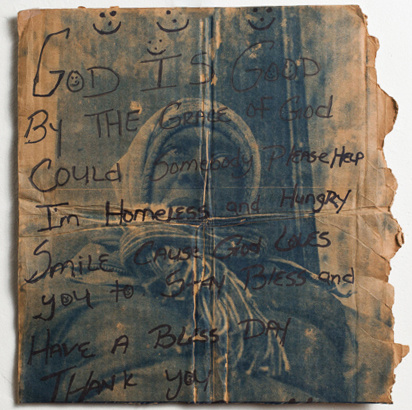Daniel Gamez is a Chicago-based artist, photographer. His works are currently being shown in I,Be – A Poets & Artists Magazine exhibition curated by Janice Bond at Elephant Room Gallery’s Bridgeport location. I, Be is a group show associated with identity. For his series Homeless, Please Help, Daniel Gamez interviewed homeless people in Chicago and LA, purchased their cardboard and asked them to take a photograph.
Cui: Let’s start from a bit of your background. What makes interested in art or photography?
Gamez: I am 26; born and raised in Chicago. My parents are immigrants from Mexico, so I am first generation American.
Cui:What makes you interested in Art or Photography?
Gamez: My interest starts when I was younger. When I was a kid, there was always an adult asking, what do you want to do when you grow up? So, in my mind, I was interested in Spiderman. So I was like I want to be a photographer. Not because I like photos, but because Spiderman takes photos. And he was able to do whatever he wanted. Yeah, so somehow that transitioned to me doing photography in high school. And from there, my interest in photography continued.

Swap-O-Rama
Cui: In regards to your two projects, Homeless, Please help and Swap-O- Rama, is there a connection to them?
Gamez: So there is actually no correlation between them, except for the theme of identity and cultural relevance. For Swap-O-Rama, that was mainly a documentary project I have been working on and am still working on currently. The reason why I want to photograph that location is that I used to work there as a teenager. It’s interesting to see these people who woke up at 5 or 6 in the morning, get there at 7,then wait an hour or two before set up. A lot of these families just trying to make a living. So it’s interesting to see from the perspective of a vendor and a buyer. I went there as a child with my family just for something to do and to look for things to buy. I wanted to document from the perspective of the seller for this project and deal with that identity. The homeless project is also about identity. I’ve had this idea to work with the concept of homeless for a while. It originally started with me creating human-like figures out of garbage, and then putting those in places and then photographing them. Then it got way too complicated. I started to collect a lot of garbage in my home. And it kind just got too difficult to create in a small space.

Swap-O-Rama
Cui: What kind of things do you want your audience to perceive through your projects?
Gamez:I really want the audience to engage with people again. For example, if you walking down the street, you see a homeless person. There is no engagement between you and that person. You just pass by as a passive viewer. With my work, I want you stop being a passive viewer and start to engage with this person and who they are.

James A. Korosa
2014, 17×24, cyanotype on cardboard
Cui: What’s the connection between the cardboard, the cyanotype process and your subjects?
Gamez: I never really thought about the connection between cyanotype as a process to the homeless people. I guess the reason why I used cyanotype is that it was that it was a new medium that I was trying out. In a sense, the process of cyanotype itself and homelessness are timeless concepts so it makes sense to connect them.

Brenda Jackson
2014, 15×14, cyanotype on cardboard
Cui: What is the process as you approach your subjects for the homelessness project?
Gamez: When I approach them, most of the time, they are sitting on the ground. I say, “Excuse me, Can I sit down?” and most of the time, they would say yes. I sit down and start talking, introducing myself and why I am approaching them. From there, I explain my project to them. And they say, “oh that’s cool”. That’s when I offer to purchase their sign. A hundred percent of the time, they are willing. After I exchange for the sign, I ask them if I can take their photograph. I then hold a conversation with them, a sort of interview. I record their age, where they from, why are they in the city that they currently in. Majority of the times, people that are in Chicago are actually from elsewhere. Same thing with LA, most of them are not from LA at all. It’s really interesting just to engage their history, where they are, who they are, and how they ended up homeless.

Lee Giletta
2014, 15×19, cyanotype on cardboard
Cui: What’s next?
Gamez: I don’t think the project is finished yet. I currently have a Chicago and LA version. Obviously New York has the biggest population of homeless so I still wanna go there. I also want to check out rural areas as opposed to urban areas. To compare and contrast those situations would be interesting. Maybe continue the project overseas and then hopefully see correlation between homeless people in America and homeless people in Europe. Maybe after a few hundred pieces, I will see where else I can branch out.
Daniel Gamez Website: http://danielgamezphotography.com/